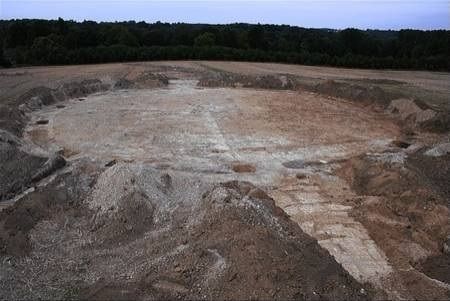Post by UKarchaeology on Aug 12, 2015 13:43:37 GMT

(2012) An ancient ceremonial site the size of Stonehenge has been discovered on the North Downs.
The exact purpose of the site - a neolithic “henge” near Hollingbourne - remains shrouded in mystery, but a large amount of burnt bone and pottery uncovered suggest it was used in a ritual capacity for almost 2000 years, as far back as 2500BC, the end of the Stone Age.
Dr Paul Wilkinson (pictured below) of the Kent Archaeological Field School, which led the investigation, said the first tantalising clue had come in the form of a circular mark spotted in satellite images of a tract of land called The Holmsdale, near the Pilgrims Way.
Digging began last month and has revealed a 50 metre wide henge - a large earthwork consisting of a circular area surrounded by a ditch and a perimeter bank - which has horn shaped entrances to the east and west.
“I couldn’t believe the size of it,” said Dr Wilkinson. “When you saw it you knew it was special.
“It’s a magnificent monument which would have taken a lot of time to create. It’s a brilliant site.”
Also uncovered in the dig were antlers and cattle shoulder blades, which archaeologists believe could have been used as pick axes and shovels by the workers who first dug the henge out.
The lack of any sign of habitation within the circle further strengthens the theory that it had a ritual use.
The burnt remains of human bones are likely to have been from cremations, while its east-west entrances could have been aligned to mark the sunset and sunrise.
With the surrounding landscape blocked from view, those standing in the henge can see only the sky - so could the henge and its alignment have some astronomical or astrological purpose?
Dr Wilkinson says looking at prehistory is like “looking into a void” and any theories are speculative.
“With prehistory, it’s very enigmatic but really we have no idea,” he said. “We approach it from 21st Century mind-set but you have to put your head into the heads of those who built it, which is difficult.”
But the discovery is undoubtedly significant.
Previously discovered Bronze Age barrows, ancient springs and trackways nearby meant the area was long known to have prehistoric importance, but the discovery of a henge - rare in South East England and almost unheard of in Kent - makes the site doubly significant.
When is a henge not a henge? - when it’s Stonehenge.
According to some experts Stonehenge is not technically a henge, because its enclosing bank is surrounded by its ditch, rather than vice versa, as in a true henge.
The world famous Wiltshire site might be recognised for its great Sarsen Stones and supposedly sacred bluestones, but the stones are irrelevant to its status as a henge earthwork.
A neolithic earthwork was constructed at the site of Stonehenge around 3500BC, about a thousand years before the famous stone structure was erected, and it is possible rings of wooden posts preceded the first stones at the site.
But the discovery of one so close to the Medway Megaliths - the ancient stone structures at Aylesford, Trottiscliffe, and Addington, also unique in the South East - adds weight to speculation that the North Downs around Maidstone was an area of great importance in Stone Age Britain.
Work will continue to date remains found at the henge, and further investigation is planned with a geophysical survey and more archaeological field-walking at Holmsdale.
(pics/source: www.kentonline.co.uk/kent/news/ancient-henge-discovered-in-nort-a60919 )
